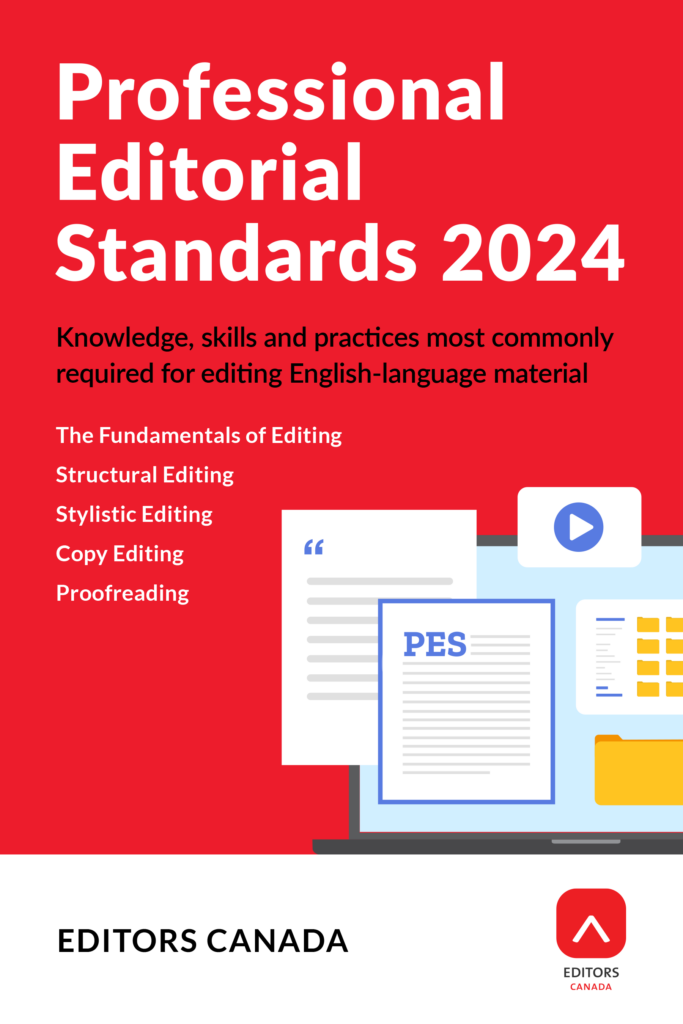Copy editing is reviewing material to ensure correct and consistent grammar, punctuation, spelling and usage. It often includes checking that the required elements of the content are accurate and complete.
A professional copy editor meets the Standards in Part A: The Fundamentals of Editing and meets the following Standards.
D1 Correctness
D1.1 Correct errors in grammar (e.g., lack of subject–verb agreement, incorrect pronoun case).
D1.2 Correct errors in punctuation (e.g., comma splices, misplaced colons, incorrect apostrophes). Know when exceptions can be made (e.g., in fiction or advertising copy).
D1.3 Correct errors in spelling (e.g., typographical errors, errors arising from homonyms).
D1.4 Correct errors in usage (e.g., words commonly confused, such as imply/infer; incorrect idioms and phrases, such as doggy-dog world for dog-eat-dog world).
D1.5 Where appropriate, point out words and phrasing that can be considered harmful, disrespectful or difficult to understand, keeping in mind conscious language and plain language principles.
D2 Consistency
D2.1 Develop a style sheet, or follow one that is provided, to track, identify and consistently apply editorial style (e.g., abbreviations; treatment of numbers; vernacular usages; Canadian, British or American spelling).
D2.2 Ensure the correct method of documenting sources is applied
(e.g., reference list, footnotes, links). Consistently apply an editorial style for sources (e.g., MLA, Chicago) appropriate to the material or as directed.
D2.3 Resolve variations in terminology, logic and mechanics (e.g., spelling, numbers, abbreviations).
D2.4 Ensure all tables, visual elements and multimedia match the surrounding text and are consistently presented (e.g., heading and caption styles, numbering).
D2.5 Understand the issues related to using other languages, especially French, in an English context (e.g., capitalization, italicization, diacritical marks) and edit for consistency.
D3 Accuracy
D3.1 Correct or query general information that should be checked for accuracy (e.g., quotations, URLs) using standard research methods and tools (e.g., dictionaries, maps, calculators, search engines).
D3.2 Review visual material (e.g., labels, cross-references, callouts on illustrations) and organizational information (e.g., tables of contents, menus and links in online documents) to ensure they are accurate, and correct or query as required.
D3.3 Correct or query errors in material containing statistics, mathematics and numerals (e.g., calculations, incorrect imperial or metric conversions, incorrect totals in tables).
D3.4 Identify and query any spelling or grammar errors within quotations to ascertain whether they were errors in the original text.
D4 Completeness
D4.1 Check for missing information and query or supply missing elements (e.g., captions and headings, web links, contact details).
D4.2 Recognize and flag places where citations are needed (e.g., quotations without attributions, unsupported generalizations in academic work, tables without sources).
D4.3 Recognize elements that require copyright acknowledgement and permission to reproduce (e.g., quotations, multimedia, visual elements). Check that permissions have been obtained. If necessary, bring the matter to the appropriate person.
Professional Editorial Standards 2024 contents

Introduction
A. The Fundamentals of Editing
B. Standards for Structural Editing
C. Standards for Stylistic Editing
D. Standards for Copy Editing
E. Standards for Proofreading
Appendix
Download Professional Editorial Standards 2024.
Looking for the previous edition? Download Professional Editorial Standards 2016.